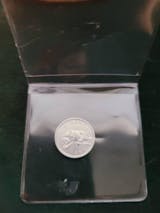elemintalshop
Leopard 10 Sengi Congo Authentic Coin Money for Jewelry and Craft Making (1967) (Wild Cat) (Big Cat)
Leopard 10 Sengi Congo Authentic Coin Money for Jewelry and Craft Making (1967) (Wild Cat) (Big Cat)
Couldn't load pickup availability
Leopard 10 Sengi Congo Authentic Coin Money for Jewelry and Craft Making (1967)
Reverse: Leopard crouching on branch, date below
Lettering: DIX SENGI
1967
Obverse: Denomination within circle
Lettering: BANQUE NATIONALE
10S
DU CONGO
Features
Issuer Democratic Republic of the Congo
Period Republic of the Congo (Léopoldville) › Democratic Republic (1964-1971)
Type Standard circulation coin
Year 1967
Value 10 Sengi = 1/10 Likuta = 1/1000 Zaïre (0.001 ZRN)
Currency Zaire (1967-1993)
Composition Aluminium
Weight 0.7 g
Diameter 17 mm
Thickness 1.39 mm
Shape Round
Orientation Coin alignment ↑↓
Demonetized Yes
Number N# 3536
References KM# 7, Schön# 40
Wikiipedia:
The leopard (Panthera pardus) is one of the five extant species in the genus Panthera, a member of the cat family, Felidae. It occurs in a wide range in sub-Saharan Africa, in some parts of Western and Central Asia, Southern Russia, and on the Indian subcontinent to Southeast and East Asia. It is listed as Vulnerable on the IUCN Red List because leopard populations are threatened by habitat loss and fragmentation, and are declining in large parts of the global range. The leopard is considered locally extinct in Hong Kong, Singapore, South Korea, Jordan, Morocco, Togo, the United Arab Emirates, Uzbekistan, Lebanon, Mauritania, Kuwait, Syria, Libya, Tunisia and most likely in North Korea, Gambia, Laos, Lesotho, Tajikistan, Vietnam and Israel. Contemporary records suggest that the leopard occurs in only 25% of its historical global range.
Compared to other wild cats, the leopard has relatively short legs and a long body with a large skull. Its fur is marked with rosettes. It is similar in appearance to the jaguar (Panthera onca), but has a smaller, lighter physique, and its rosettes are generally smaller, more densely packed and without central spots. Both leopards and jaguars that are melanistic are known as black panthers. The leopard is distinguished by its well-camouflaged fur, opportunistic hunting behaviour, broad diet, strength, and its ability to adapt to a variety of habitats ranging from rainforest to steppe, including arid and montane areas. It can run at speeds of up to 58 km/h (36 mph). The earliest known leopard fossils excavated in Europe are estimated 600,000 years old, dating to the late Early Pleistocene. Leopard fossils were also found in Japan[8] and Sumatra.
The leopards has featured in art, mythology and folklore of many countries. In Greek mythology, it was a symbol of the god Dionysus, who was depicted wearing leopard skin and using leopards as means of transportation. In one myth, the god was captured by pirates but two leopards rescued him. During the Benin Empire, the leopard was commonly represented on engravings and sculptures and was used to symbolise the power of the king or oba, since the leopard was considered the king of the forest. The Ashanti also used the leopard as a symbol of leadership, and only the king was permitted to have a ceremonial leopard stool. Some African cultures considered the leopard to be a smarter, better hunter than the lion and harder to kill.
In Rudyard Kipling's Just So Stories How the Leopard Got His Spots, a leopard with no spots in the High Veldt lives with his hunting partner, the Ethiopian. When they set off to the forest, the Ethiopian changed his brown skin, and the leopard painted spots on his skin. A leopard played an important role in the 1938 Hollywood film Bringing Up Baby. African chiefs, European queens, Hollywood actors and burlesque dancers wore coats made of leopard skins.
The leopard is a frequently used in heraldry, most commonly as passant. The heraldic leopard lacks spots and sports a mane, making it visually almost identical to the heraldic lion, and the two are often used interchangeably. Naturalistic leopard-like depictions appear on the coat of arms of Benin, Malawi, Somalia, the Democratic Republic of the Congo and Gabon, the last of which uses a black panther.
Share




















